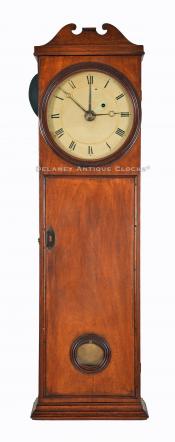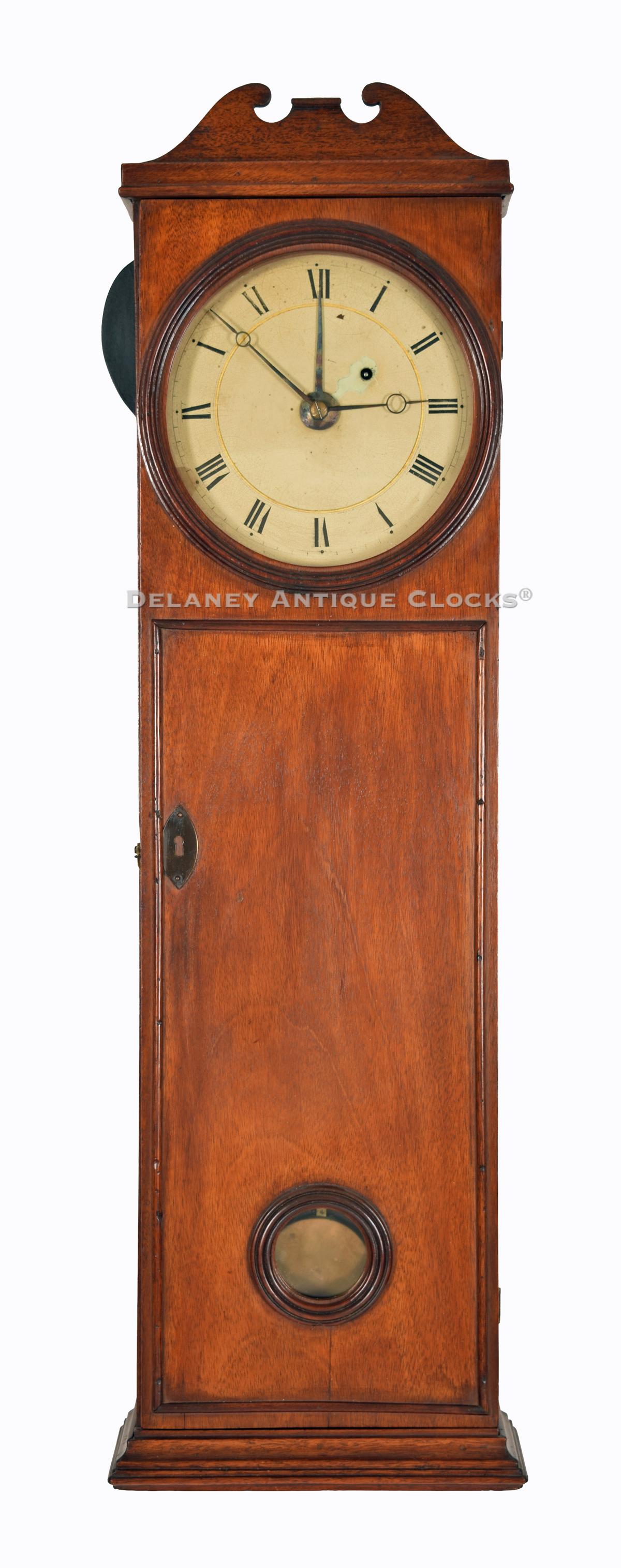Rare Elnathan Taber Mahogany case Coffin Clock. This model features a time and an alarm movement and was made in May 1817. 222097.
This is an unusual and interesting variant of Simon Willard's Patent Wall Timepiece. This may be one of the most challenging variations to find. So few of these have come onto the marketplace in the last 50 years. Because of this, it is logical to assume that the number of examples originally made was limited. Curiously, this example is the most developed version currently known to us. The applied moldings on the door really dress this case up.
The case is neatly constructed in mahogany and retains an older surface. The case is dovetailed. These are hidden behind the applied molding located at the top and bottom of the case. The complex base molding consists of multiple steps and coves. This molding is fitted to the bottom of the case in such a manner that this example can also be used as a shelf clock. Of the less than half a dozen examples known to us, this is the only example that incorporates this case feature. At the top of the case is a simple swan's neck pediment. This is framed with additional molding that balances the case form to the eye. The front of the cabinet opens as a door. It is hinged on the right and is secured with a hook. One will notice that the two circular openings, one for the dial and the other for the brass-faced pendulum bob, are trimmed with stylish bezel moldings. These openings are for viewing and are fitted with protective glass. The rectangular pattern on the forward-facing surface of the case is made with a half-round molding. Unhook the latch on the left side, and the door opens to access the case's interior. A mahogany mask board is used to frame the dial.
This iron dial is painted, and the time ring is formatted with Roman-style hour numerals. The minute ring is closed. This dial is also decorated with a thin gilt inner ring. The hour and minute open moon hands are wonderfully hand filed and display the time. I should turn one's attention to the third or extra hand on this dial. This hand is used for setting the alarm.
This clock features a separate alarm mechanism that is mounted behind the mask board. When activated, the alarm uses a hammer to strike a bell mounted on the left side of the case. The bell is covered or protected with a piece of tin that is mounted to the side of the case. The tin is skillfully shaped and is designed to let the sound of the bell travel across the room. The alarm movement is wound independently of the time movement. Once set and fully wound, it is designed to operate a full week before it needs to be rewound. It is powered by its' original lead bob weight that is fitted with a "duck-bill hook." The weight travels in a channel on the left side of the case.
The time movement is also weight driven and designed to run for eight days on a full wind. Please note that the original time weight descends down a channel in the center of the case directly below the works. This channel is framed in pine. The movement features brass construction. Two brass rectangular-shaped plates frame the gearing and are joined by four brass pillars. As is the Taber tradition, the front plate bears a number of fascinating engravings. Many of these were done by Elnathan as a record of the clocks' service over the years. Elnathan engraved his name on the front plate on at least three occasions and dated it several times. The inscriptions that are legible read, "1822, cleaned by E. Taber 1829, 1/27/1838, E. Taber Nov 3, 1843, / cleaned Jan 17, 1846..." There are additional dates that are also engraved in another hand, suggesting that another repairman also maintained the clock. These include "1/27/1838" and a "G. W?? 1856 / nov 13 1865." The most exciting and important engraved information reads, "Made In May 1817." This is located below the idler wheel. It is very unusual to have this type of information about a first-period clock. This is a great find. The movement is mounted to the backboard with two screws that are diagonally positioned on the back plate. The pendulum is supported on a T-Bridge suspension post. Overall, the movement is of excellent quality, which is quite typical of this Maker. The pendulum is constructed with a steel rod and a brass-faced lead bob. The brass face is, of course, visible through the lower opening in the front door. The motion of this indicates the clock is operating.
In the lower section of the case, a piece of painted black tin. Its purpose is to separate the bob from the weight. It is in this location that the clock is signed. The Maker signed in script, "Warranted by E. Taber / Union Street Roxbury." A brass cross piece will secure the pendulum to it for travel. This brass piece is engraved with an "S" on the left of the center and an "F" right of the center. This indicates the direction to turn the threaded nut to adjust the rate.
This attractive clock measures approximately 35 inches long, 8 and 7/8 wide, and 3.5 inches deep. We know that it was made in May 1817.
It is inventory number 222097.














